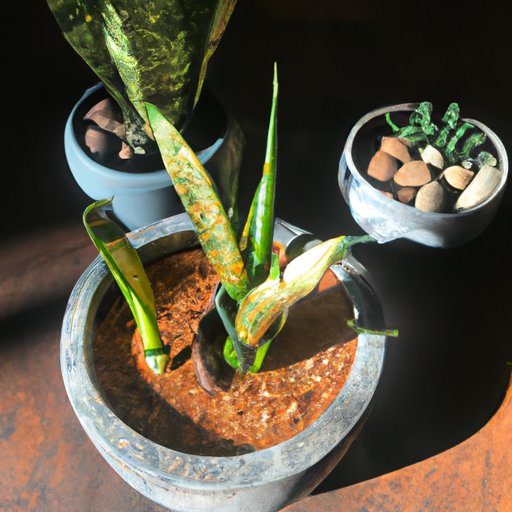Introduction
Snake plants (Sansevieria trifasciata) are a popular houseplant due to their striking, architectural foliage and low-maintenance nature. Though they can survive in low light conditions, providing the right care for your snake plant can help it thrive. This article will explore the basics of caring for a snake plant indoors, including how to choose the right pot and soil, find the ideal location, and provide regular watering and fertilization.
Choose a Pot with Good Drainage
Snake plants need a well-draining pot to prevent root rot. When selecting a pot, make sure there are several drainage holes at the bottom. If the pot doesn’t have drainage holes, you can drill them yourself. Avoid using an overly large pot as this can cause the soil to stay too wet and lead to root rot.
Plant in Well-Draining Soil
Snake plants prefer a fast-draining soil mix. You can purchase cactus or succulent potting soil from your local garden center. To ensure adequate drainage, add a handful of perlite or coarse sand to the soil mix before planting. This will help create air pockets and improve water drainage.
Place in Bright, Indirect Sunlight
Snake plants do best when placed in bright, indirect sunlight. An east-facing window is usually the best spot in the home. If the plant is in direct sun, the leaves may scorch. Be sure to rotate the plant occasionally so all sides receive equal amounts of light.
Water Sparingly and Regularly
Snake plants don’t require frequent watering. During the growing season (spring and summer), allow the top 2–3 inches of soil to dry out before watering. In winter, reduce watering and only water when the soil is completely dry. Over-watering can lead to root rot and is one of the most common causes of death for indoor snake plants.
Keep the Temperature Consistent
Snake plants prefer temperatures between 65–80°F (18–27°C). Keep the plant away from cold drafts and extreme temperatures. If the temperature drops below 50°F (10°C), the plant may suffer damage.

Fertilize During Active Growth Periods
Snake plants should be fertilized during the spring and summer months when they’re actively growing. Use a balanced liquid fertilizer diluted to half-strength. Don’t fertilize during the fall and winter months when the plant isn’t actively growing.
Prune When Necessary
Snake plants grow slowly, but may need occasional pruning. Prune off any yellow or brown leaves as these are signs of over-watering or disease. Snip off dead flower stalks, and trim back lanky stems to encourage bushier growth. Use clean, sharp scissors or pruners when pruning.
Conclusion
Caring for a snake plant indoors can be easy if you follow these basic guidelines. Select a pot with good drainage, fill it with a fast-draining soil mix, and place in bright, indirect sunlight. Water sparingly and regularly, keep the temperature consistent, fertilize during active growth periods, and prune when necessary. With proper care, your snake plant will thrive and bring beauty to your home.


